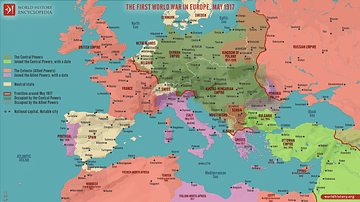Illustration
This map illustrates the Russian Revolution of 1917, a transformative year that saw the collapse of the Russian Empire and the rise of Soviet rule. Triggered by the February Revolution (8–16 March 1917, O.S. 23 February – 3 March), mass protests and mutinies forced Tsar Nicholas II (reign 1894–1917) to abdicate, ending over three centuries of Romanov rule. A Provisional Government briefly assumed power but struggled to maintain authority amid continuing war and social unrest.
The return of Vladimir Lenin (16 April 1917, O.S. 3 April) and his Bolshevik faction galvanized opposition, culminating in the October Revolution (6–8 November 1917, O.S. 24–26 October), when the Bolsheviks seized Petrograd and declared a Soviet government. Across the empire, workers’ councils (soviets), mutinous soldiers, and disaffected nationalities rose up. Latvia, Ukraine, Georgia, and others moved toward independence, while regions like Don, Orenburg, and Transcaucasia declared autonomy. The revolution ignited civil war, dismantled imperial institutions, and reshaped Eurasia’s geopolitical future under the Soviet banner.
About the Author
Cite This Work
APA Style
Netchev, S. (2025, July 28). Map of the Russian Revolution of 1917. World History Encyclopedia. Retrieved from https://www.worldhistory.org/image/20702/map-of-the-russian-revolution-of-1917/
Chicago Style
Netchev, Simeon. "Map of the Russian Revolution of 1917." World History Encyclopedia. Last modified July 28, 2025. https://www.worldhistory.org/image/20702/map-of-the-russian-revolution-of-1917/.
MLA Style
Netchev, Simeon. "Map of the Russian Revolution of 1917." World History Encyclopedia. World History Encyclopedia, 28 Jul 2025, https://www.worldhistory.org/image/20702/map-of-the-russian-revolution-of-1917/. Web. 30 Jul 2025.








